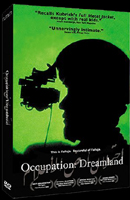 BUY IT AT AMAZON: CLICK HERE!
BUY IT AT AMAZON: CLICK HERE!
STUDIO: Rumur Releasing
MSRP: $24.98
RATED: NR
RUNNING TIME: 140 Minutes
SPECIAL FEATURES:
• Commentary w/ filmmakers and subjects
• Historical timelines
• War-critical essay
• War footage
• Deleted scenes
• Trailers
The Pitch
"Prelude
to an assault, and no one makes beautiful music together."
The Humans
Directed
by Ian Olds and Garrett Scott and featuring a number of the soldiers from the
82nd Airborne division.
The Nutshell
In the
winter of ’03/’04, Scott and Olds were attached to the 82nd Airborne in the
Iraqi city of Falluja and given mostly free rein to film what they saw. They
were present during the buildup to the major offensives on the city, the social
paranoia and soup of unrest that boiled over in April of that year. The
filmmakers managed to capture a number of candid interviews with the soldiers,
as well as the brief moments of excitement that punctuate the lives of an
occupying force.
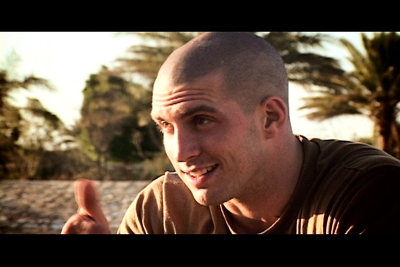
"Joke’s on you! I’ve still got it right here, sucker!"
The Lowdown
So, the
question is: what side of the fence do the filmmakers come down on? Is Occupation:
Dreamland (named after the converted barracks the division used as
base) critical of the war, or in support of it? Do they condemn the occupation
or rationalize its good qualities? It’s not as simple as that, of course, but I
can do a brief summary for the talking points crowd: Occupation: Dreamland is
a wholly successful study on the negative impact of war on individuals. The lives of the soldiers and their interactions
with the Iraqi people on the street are fronted, while the political morass is
reduced to a churning, inaudible gear.
As some
of the promotional material suggests, Dreamland recalls in tone Kubrick’s Full
Metal Jacket, the primary difference being that this story isn’t
fictional. There are individual soldiers who recall some of the archetypes that
crop up in fiction: the poser, the apathetic, the brash, young leader. These
soldiers interact as you’d expect if you’re at all familiar with war movies,
which creates a compelling bit of cognitive dissonance in the way that fiction
and reality illuminate each other.
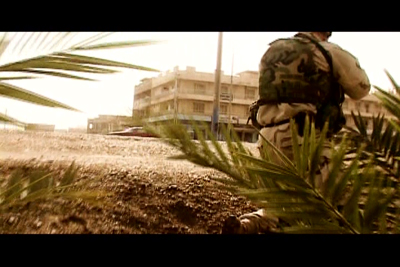
Tom Clancy just had a great idea.
Being
real people, of course, the soldiers are not confined to their archetypes. The
filmmakers spend a little time with each of them, getting at their backstories,
uncovering their reasons for joining the infantry. Each puts on a face for the
camera, but there’s no telling if that face is the same one they put on for
their lives; you get the sense that a false exterior has been erected in front
of each soldier, but it’s nothing more than a sense, and it adds considerably
to their humanity.
A
considerable amount of the film’s success can be attributed to the filmmaker’s
sense of pacing, always a handy challenge to your garden variety documentarian.
Olds and Scott have created a recognizable arc out of their footage, a rise and
fall of a conflict much more subtle than the gunplay and violence of the
full-scale assault on Falluja. The chief player in this conflict is
Information, and the drama surrounds its distribution and damming in many
different forms. There are the sections that deal directly with combat
information — a particularly compelling sequence has one squad in fruitless,
scattered pursuit of an insurgent with a rocket-propelled grenade — and those
that deal with less urgent topics, such as the soldiers’ opinions of
international politics.
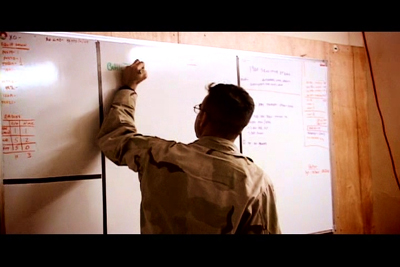
"C’mon guys, brainstorm! I’ll get us started. ‘Corsets,’ ‘quick-set cement,’
and ‘a horsey.’ All right. Anybody else?"
One of
the obstacles that stands in the way of documentarians creating films of
current events is that, rather than overcoming the audience’s disbelief, as
fiction has to, they have to overcome the audience’s preconceived notions. It
would be foolish to make a film that did nothing but support the stereotypes
that populate the reductionist conversations that we Americans have around the
ol’ water cooler, and it would be intensely difficult (and possibly misguided)
to create a documentary that did nothing but subvert those stereotypes.
Olds and
Scott have done neither. By identifying with the soldiers of the 82nd Airborne,
they instead attach a wealth of sympathy to a situation that perhaps does not
deserve it, acknowledging the cognitive dissonance. It’s not just that there’s
a human face on the conflict, but that there are those human faces in
particular attached to the conflict. They’re not every man; they are
individuals, which engenders stronger compassion and interest.
The
educational factors are present and worthy, but Dreamland is not a lesson
in current history. It is a fascinating, ground-level experience of what
happens to all sorts of information in the middle of international argument, be
it military-to-military, or military-to-civilian. Even more than that, it’s
about what the teeth on the gears do with the information they’re given.
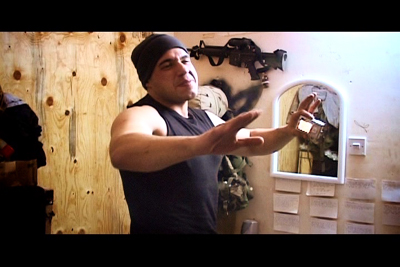
"I hug, but I don’t that hug, know’umsayin’?"
The Package
Here’s a
great example of bonus features expanding the experience of the movie, rather
than simply revisiting it. In addition to a rather low-tempo commentary track
with the filmmakers and select soldiers, there is a timeline of events that
have occurred in Falluja since the major offensives of two years ago. The
filmmakers have also included unedited, ground-level footage from the major
military operations in Falluja, and included a few deleted scenes that expand
more the characters of the subjects.
Included
in the liner notes is a visual representation of the timeline of the Iraqi
conflict, as well as a short, somewhat bitter, but well-defended essay by
Christian Parenti. The last major feature of note is a "where are they
now" section that catches up on the lives of the soldiers of the 82nd,
which is fascinating instead of being cheesy.
Audio and
video quality are serviceable, as is the night-vision cover art. Simple and
striking just about covers all the bases.
8.1 out of 10